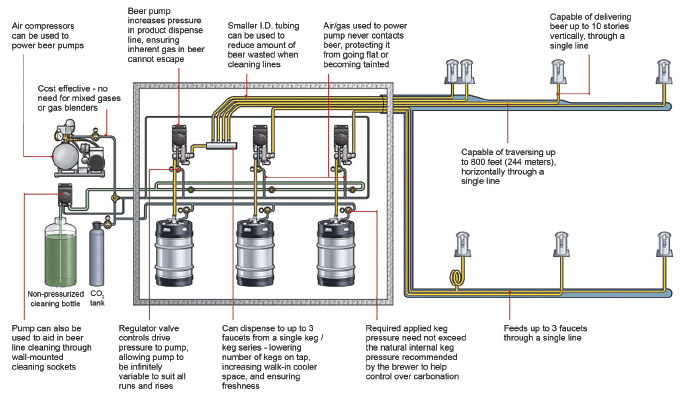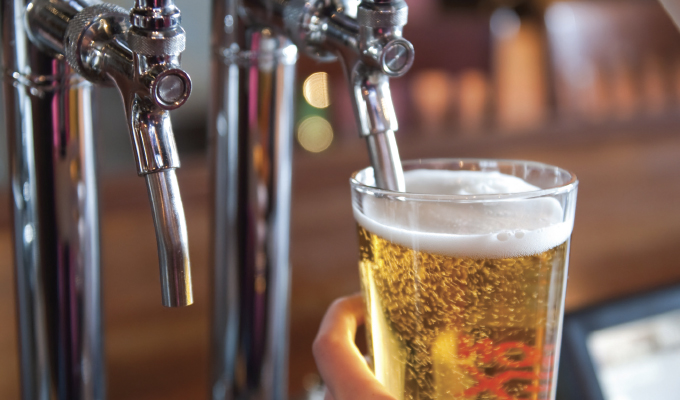In a competitive environment, it is essential that a “live” product like beer reaches the consumer in prime condition in order to retain its flavor and the characteristics that make it unique, just as the brewer intended. The beer also needs to be dispensed at a rate that supports venue business levels, and the skill level of the serving staff behind the bar.
To meet the above requirements, one of the most effective methods of packaging beer is in stainless steel or aluminum kegs. Kegs transport and dispense mass quantities of beer without impacting its quality or taste by protecting it from exposure to oxygen and sunlight. Kegs also allow the beer to be dispensed easily and quickly for more fast and efficient service.
Because space in the bar is often limited, kegs are normally stored remote from the bar area, so the beer needs to be moved from the cellar or storeroom to the tap on the bar. However, the taste of every beer dispensed from a keg that’s stored remotely can be hit or miss depending on the distance it needs to travel and the temperature at which it has been stored.
With so many variables at play, having the right beer dispense system is critical to ensuring the perfect pour—from the barrel to the bar, every time.
PERFECTING THE POUR
Typically, systems that push beer through dispensing systems are carbon dioxide gas or blended gas assisted, which is why it can be challenging to perfect the pour. To transport the beer from the keg to the bar, gas pressure above the level required to maintain the beer at brewery standard is applied to the top surface of the beer, pushing the beer through the tubing to the bar.
Head pressure, as recommended by the brewer, effectively delivers the beer to the glass over short line distances. The further the keg is from the bar, the greater the applied gas pressure needs to be—this means recommended head pressure plus added pressure transports the beer from the keg to the glass. Whenever the head pressure applied to the beer exceeds the equilibrium pressure recommended by the brewer, it is easy for the incorrect pressure to be set. This results in conditions where the pressure is either too high or too low.
Over time, excess pressure leads to more carbon dioxide being absorbed by the beer. This is known as over carbonation and has two major drawbacks:
- Foaming: Carbon dioxide released on dispense leads to too much foam on the beer head, making it difficult to dispense.
- Flavor: Too much foam impacts the texture and taste of the beer, resulting in a negative experience for the consumer.
The opposite of over carbonation is under carbonation or flat beer. This occurs when the pressure applied to the keg is too low. In under carbonation conditions, the carbon dioxide gas in the beer escapes in the keg until the equilibrium pressure is reached. The result is a flat beer, which destroys the taste and texture of the beer, spoiling the experience of the end customer.
The beer pump was developed to overcome such challenges. Unlike traditional (non-pump) dispense methods, the pressure on the keg remains constant at the equilibrium pressure. Maintaining constant equilibrium pressure on any keg means the taste of the beer remains exactly as the brewer intended and the consumer gets a distinct, satisfying, truly enjoyable glass of beer with every pour.

PUSH AND PULL PUMPING
The use of beer pumps, particularly in environments where excess top pressure is required to traverse a distance, allows an installer and operator to maintain equilibrium pressure in any given circumstance. There is no need to put extra pressure on the beer to effectively move it through the system. Instead, drive pressure is applied to the pump to move the beer. The drive pressure effectively acts like a car accelerator—the more you put into the pump, the quicker it operates.
Beer pumps consist of an air chamber, where the drive pressure comes in, and two wet chambers where the beer passes through. The two wet chambers are separated by seals known as diaphragms. Because of this design, the drive gas never comes into contact with the beer. A special shuttle valve forces the air pressure behind each of the diaphragms in turn, allowing one piston to gently suck the beer in, while the other pushes it out the other side.
This push-pull action draws the beer from the keg and gently pushes it through the tubing to the bar. When the dispense tap is opened, pressure in the line drops below the drive pressure in the air chamber so the pump runs, feeding the beer line to the bar. When the faucet is closed, the pressure in the line rises to a point where the beer pump stops. It remains stopped until the faucet is opened again to dispense beer.
BENEFITS OF BEER PUMPS
For those in the know, there are several benefits found by using beer pumps—benefits that range from serving quality and storage to adaptability and the bottom line:
- Beer is maintained at equilibrium pressure, preventing over carbonation.
- Beer can be moved over longer distances, allowing kegs to be stored remotely.
- Dispense speed can be adapted to meet business demand and skill level of serving staff.
- Dispense speed and presentation is consistent with every pour.
- The perfect pour prevents beer wastage, saving money.
- Less carbon dioxide is used as the beer pump can be driven using a compressor.
SOLUTION SPOTLIGHT: XYLEM FLOJET G56 BEERJET
Designed to take the variability out of beer dispensing systems, Xylem’s Flojet G56 Beerjet pump offers enhanced beer quality—from the top to the bottom of every barrel—without impacting taste. Powered by gas or compressed air, the beer is pushed through the lines to the tap without the gas or air ever coming into contact with the beer.
The result? A perfect pour, from the barrel to the bar, every time. Key product features include:
- Can traverse up to 800 feet horizontally through a single line.
- Can deliver beer neatly over 100 feet vertically through a single line.
- Can dispense multiple faucets (up to three) from a single key or keg series, lowering the number of kegs on tap.
- Can dispense 300 gallons (2,400 pints) of draft beer per hour.
- Has a service life of more than 70,000 gallons (560,000 pints).
The Flojet G56 Beerjet pump is also easy to clean and maintain and can be used as a line-cleaning pump. By disconnecting the keg coupler and submerging it in a line cleaning solution, the pump will gently draw the solution in and pump it through the system right through to the faucet.
Compatible with the Flojet Line Buddy flow reversal valve, operators can optimize line cleaning processes by running cleaning solutions through the Flojet G56 Beerjet pump in both directions. Running a cleaning solution through a beer system in alternating directions—from the faucet to the tap and back again—has been found to optimize line and pump sanitation. Flow reversal valves are an important accessory in beer pump systems.
PUMPING IN ACTION
In conclusion, let’s do a brief rundown of installation tips before you try out your next perfect pint:
- Clean, dry gasses (carbon dioxide, nitrogen, blended gasses, or compressed air) should be applied at 15-90 PSI for gas inlet operating pressure. Calculations for gas pressure additions are used as a starting point to power the pump. Only the equilibrium pressure specified by the brewer should be maintained on the keg
- For optimal results, beer pumps must be mounted directly inside the cooler or cellar wall. Universal mounting brackets can be used to aid installation
- When using a carbon dioxide or nitrogen exhaust, gas must vent outside of the cooler or cellar into a space that is well ventilated, preventing buildup of carbon dioxide or nitrogen. Always check gas or liquid connections to prevent against gas or beer leaks within the system
- To improve system efficiency, “Foam On Beer” (FOB) detectors are recommended. Installing FOBs on each beer line stops pumping action when the keg or tank is empty, which also supports key change overs
- For multi-pump installations, incorporating a flow reversal valve will help clean lines in a loop, using the beer pump to drive the cleaning solution through the system rather than needing a separate pump
- When installing the system, it is important to ensure that the dispense rate, which is determined by setting the drive gas pressure on each pump, is set to match the skill level of serving staff
- If you have any application questions before, during or after installation, always contact your solution provider
FOR MORE INFORMATION
David Allen is director of product management and marketing for Flojet, Jabsco, and Rule. Xylem is a leading global water technology company committed to solving critical water and infrastructure challenges with innovation. The company’s 17,000 diverse employees delivered revenue of $5.2 billion in 2021. Xylem is creating a more sustainable world by enabling its customers to optimize water and resource management, and helping communities in more than 150 countries become water secure. For more information, visit www.xylem.com.
MODERN PUMPING TODAY, May 2023
Did you enjoy this article?
Subscribe to the FREE Digital Edition of Modern Pumping Today Magazine!


